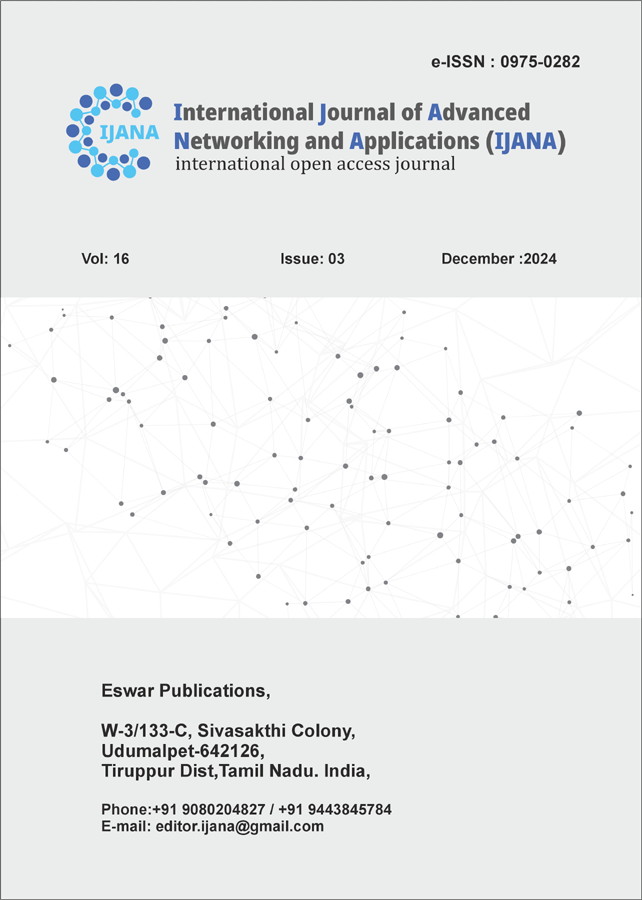Miniaturization of Microstrip Patch Antenna Using Fractal Geometry
Hameedullah Khan Department of Electrical Engineering, University of Engineering & Technology Peshawar, Pakistan Email: 19pwele5523@uetpeshawar.edu.pk
DOI:
https://doi.org/10.35444/IJANA.2024.16301Keywords:
Fractal antenna, Inset-fed, Microstrip Patch Antenna, Miniaturization, Sierpinski CarpetAbstract
This paper demonstrates the miniaturization of microstrip patch antenna through the induction of fractal geometry. By using the space filling properties of fractals, a unique patch antenna operating at 2.20 GHz is achieved as compared to conventional antenna which is operating at 2.46 GHz frequency, this is due to the increase of electrical length which is inversely proportional to operating frequency. The design starts with an insert-fed patch antenna which is subjected to fractal iteration using a new version of Sierpinski fractal up to the 3rd iteration. Experimental results show size reduction of 31%, 32% and 33% for 1st, 2nd and 3rd iterations respectively. Not only size is reduced but also the antenna maintains performance characteristics such as reflection loss, impedance matching, antenna gain. Additionally, the propose design achieves an increase bandwidth of over 3%, which illustrates the performance get better while maintaining the frequency. The results are evidence that proposed design provides superior size reduction and improved the bandwidth to previous design.
References
REFERENCES
[1]. Ullah, Habib, et al. "Angularly Stable Band Stop FSS Loaded MIMO Antenna with Enhanced Gain and Low Mutual Coupling." Int. J. Advanced Networking and Applications 15.03 (2023): 5924-5930.
[2]. T. K. Lo and Y. Hwang,” Microstrip Antennas of Very High Permittivity for Personal Communications,” 1997 Asia Pacific Microwave Conference, pp. 253–256.
[3]. H. Mosallaei and K. Sarabandi,” Design and Modeling of Patch Antenna Printed on Magneto - Dielectric Embedded-Circuit Metasubstrate,” IEEE Transactions On Antennas And Propagation, Vol. 55, No. 1, January 2007.
[4]. N. G. Alexopoulos and D. R. Jackson, “Fundamental Superstrate (Cover) Effects On Printed Circuit Antennas,” IEEE Transactions On Antennas And Propagation, Vol. Ap-32, No. 8, August 1984.
[5]. J. P. Gianvittorio and Y. Rahmat-Samii, “Fractal Antennas: A Novel Antenna Miniaturization Technique, and Applications,” IEEE Antenna’s
and Propagation Magazine, Vol. 44, No. 1, February 2002.
[6]. J. Anguera, C. Puente, C. Borja, R. Montero, and J. Soler,” Small And High-Directivity Bow-Tie Patch Antenna Parameters
Iter 0 Iter 1 Iter 2 Iter 3 S11 -13.85 -20.30 -17.79 -15.38 VSWR 1.51 1.21 1.3 1.41 Gain (dB) 2.49 1.11 0.91 0.893 D 5.3 4.84 4.84 4.84 2.47 2.23 2.21 2.20 BW%) 2.49 3.27 3.13 3.03 IBW (%) 62 MHz 73 MHz 69 MHz 67 MHz Antenna Iter 0 Iter 1 Iter 2 Iter 3 Area 986.95 680.54 675.91 670.5
Mini. XX 31% 32% 33% Int. J. Advanced Networking and Applications Volume: 16 Issue: 03 Pages: 6374-6381 (2024) ISSN: 0975-0290 6381
Antenna Based On The Sierpinski Fractal,” Microwave And Optical Technology Letters ,Vol. 31, No. 3, November 5 2001.
[7]. Anguera, Jaume, et al. "Broad-band dual-frequency microstrip patch antenna with modified Sierpinski fractal geometry." IEEE Transactions on Antennas and Propagation 52.1 (2004): 66-73.
[8]. Kordzadeh, Atefeh, and Farrokh Hojjat-Kashani. "A new reduced size microstrip patch antenna with fractal shaped defects." Progress In Electromagnetics Research B 11 (2009): 29-37.
[9]. Mohammed, S. Sheik, K. Ramasamy, and T. Shanmuganantham. "A sierpinski fractal based microstrip patch antenna for wireless power
transmission system." International Journal of Computer Applications 1.13 (2010): 0975-8887.
[10]. Wong, Hang, et al. "Small antennas in wireless communications." Proceedings of the IEEE 100.7 (2012): 2109-2121.
[11]. Balanis, C. A. Antenna Theory: Analysis and Design, 3rd ed. Wiley, 2005.
[12]. J. P. Gianvittorio and Y. Rahmat-Samii, “Fractal Antennas: A Novel Antenna Miniaturization Technique, and Applications,” IEEE Antenna’s and Propagation Magazine, Vol. 44, No. 1, February 2002.
[13]. J. Anguera, E. Martínez, C. Puente, C. Borja, and J. Soler, “Broad-Band Dual-Frequency Microstrip Patch Antenna With Modified Sierpinski Fractal Geometry,” IEEE Transactions On Antennas And Propagation, Vol. 52, No. 1, January 2004.
[14]. S. Sheik Mohammed, K. Ramasamy, and T. Shanmuganantham, “A Sierpinski Fractal Based Microstrip Patch Antenna for Wireless Power
Transmission System,” ©2010 International Journal Of Computer Applications (0975 – 8887), Volume 1 – No. 13.
[15]. Anguera, Jaume, et al. "Broad-band dual-frequency microstrip patch antenna with modified Sierpinski fractal geometry." IEEE Transactions on Antennas and Propagation 52.1 (2004): 66-73.
Downloads
Published
Issue
Section
License
Copyright (c) 2024 IJANA - International Journal of Advanced Networking and Applications

This work is licensed under a Creative Commons Attribution 4.0 International License.
IJANA published open access under a CC BY license (Creative Commons Attribution 4.0 International License). The CC BY license allows for maximum dissemination and re-use of open access materials and is preferred by many research funding bodies. Under this license users are free to share (copy, distribute and transmit) and remix (adapt) the contribution including for commercial purposes, providing they attribute the contribution in the manner specified by the author or licensor http://Creativecommons.org//license/by/4.0/.. It allows to use, reuse, distribute and reproduce the original work with proper citation.


